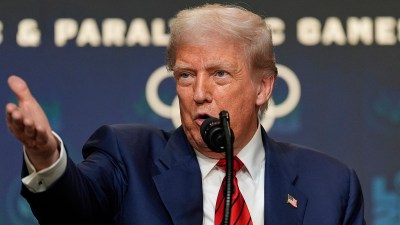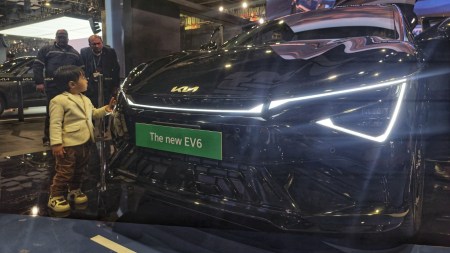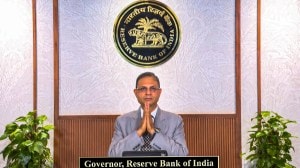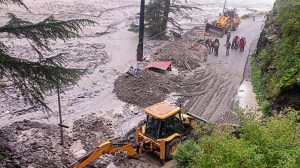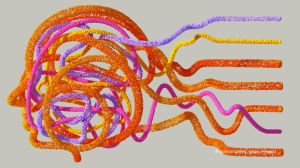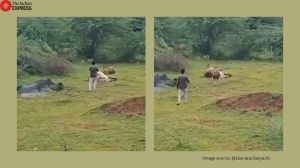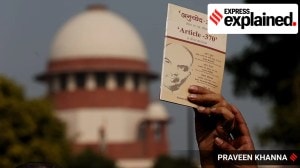UPSC Essentials | Mains answer practice — GS 2: Questions on India’s civil nuclear liability framework and India-Namibia relations (Week 110)
Are you preparing for UPSC CSE 2025? Here are questions from GS paper 2 for this week with essential points as the fodder for your answers. Do not miss points to ponder and answer in the comment box below.
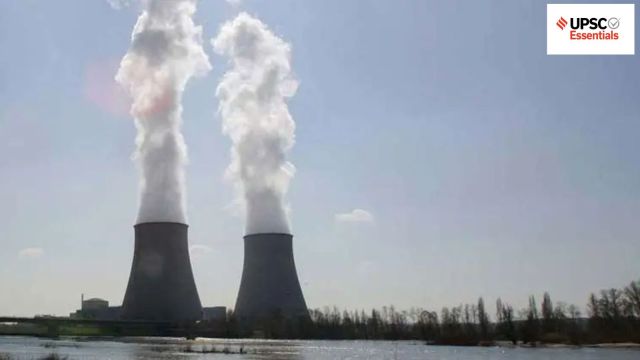 Attempt a question on India’s civil nuclear liability framework in today's answer writing practice. (Source: File Photo)
Attempt a question on India’s civil nuclear liability framework in today's answer writing practice. (Source: File Photo)UPSC Essentials brings to you its initiative for the practice of Mains answer writing. It covers essential topics of static and dynamic parts of the UPSC Civil Services syllabus covered under various GS papers. This answer-writing practice is designed to help you as a value addition to your UPSC CSE Mains. Attempt today’s answer writing on questions related to topics of GS-2 to check your progress.
🚨 Click Here to read the UPSC Essentials magazine for June 2025. Share your views and suggestions in the comment box or at manas.srivastava@indianexpress.com🚨
QUESTION 1
Discuss the role of legal reforms in India’s civil nuclear liability framework in facilitating international cooperation in the nuclear energy sector.
QUESTION 2
“India’s outreach to Namibia is a strategic step toward securing energy and digital infrastructure security.”
Discuss in light of India’s growing dependency on critical minerals and its promotion of digital public infrastructure abroad.
General points on the structure of the answers
Introduction
— The introduction of the answer is essential and should be restricted to 3-5 lines. Remember, a one-liner is not a standard introduction.
— It may consist of basic information by giving some definitions from the trusted source and authentic facts.
Body
— It is the central part of the answer and one should understand the demand of the question to provide rich content.
— The answer must be preferably written as a mix of points and short paragraphs rather than using long paragraphs or just points.
— Using facts from authentic government sources makes your answer more comprehensive. Analysis is important based on the demand of the question, but do not over analyse.
— Underlining keywords gives you an edge over other candidates and enhances presentation of the answer.
— Using flowcharts/tree-diagram in the answers saves much time and boosts your score. However, it should be used logically and only where it is required.
Way forward/ conclusion
— The ending of the answer should be on a positive note and it should have a forward-looking approach. However, if you feel that an important problem must be highlighted, you may add it in your conclusion. Try not to repeat any point from body or introduction.
— You may use the findings of reports or surveys conducted at national and international levels, quotes etc. in your answers.
Self Evaluation
— It is the most important part of our Mains answer writing practice. UPSC Essentials will provide some guiding points or ideas as a thought process that will help you to evaluate your answers.
THOUGHT PROCESS
You may enrich your answers by some of the following points
QUESTION 1: Discuss the role of legal reforms in India’s civil nuclear liability framework in facilitating international cooperation in the nuclear energy sector.
Note: This is not a model answer. It only provides you with thought process which you may incorporate into the answers.
Introduction:
— Multiple modifications to two overarching statutes governing the country’s atomic energy sector are currently being considered in the legislature. The revisions will bring them in line with worldwide legal rules, address long-standing investor concerns, and pave the way for the opening up of India’s civil nuclear business.
— The first involves the relaxation of provisions under India’s nuclear liability statute. The Civil blame for Nuclear Damage Act of 2010 (CLNDA) aims to provide a mechanism for compensating victims for damages caused by a nuclear accident, as well as to assign blame and outline compensation procedures.
Body:
You may incorporate some of the following points in your answer:
— A series of around 11 legal adjustments are now being worked up for the CLNDA, two of which are critical. One is an amendment aimed at weakening a specific component – Section 17 (b) of the CLNDA – which is perceived to be incompatible with similar nuclear liability legislation established around the world.
— According to Section 17 of the CLNDA, the operator of the nuclear installation, after paying the compensation for nuclear damage, shall have the right to recourse where – (a) such right is expressly provided for in a written contract; (b) the nuclear incident has resulted as a consequence of an act of the supplier or his employee, which includes supply of equipment or material with patent or latent defects or sub-standard services; and (c) the nuclear incident has resulted
— Provision (b) is a unique insertion into the Indian environment that is identified as an obstruction by international vendors, none of which have invested in a single project in India since the Act went into effect.
— According to the official, nuclear projects in India must be vetted by the country’s atomic regulator AERB, which is adequately competent to request that the right of recourse be specifically included in a contract in writing while clearing all future contracts.
— The second key modification in the works is to allow private corporations to enter nuclear power plant operations in India, and it may also pave the way for foreign companies to take a minority equity stake in prospective nuclear power projects.
— Amendments to the second key legislation, the Atomic Energy Act of 1962, are being proposed to allow private companies, and possibly even foreign players at a later stage, to enter nuclear generation as operators, which is currently limited to state-owned companies such as NPCIL or NTPC Ltd.
— The CLNDA reforms will effectively bring India’s nuclear liability legal framework into compliance with the provisions of the 1997 Convention on Supplementary Compensation for Nuclear Damage (CSC), which attempted to establish a global liability regime. According to this, a country that is a party to either the 1963 Vienna Convention or the 1960 Paris Convention may automatically become a party to the CSC, while a country that is not a party to either of these conventions may also become a party to the CSC if its national law on nuclear liability complies with the provisions of the CSC and its annexures.
Conclusion:
— India, which is not a party to the Vienna or Paris Conventions, signed the CSC on October 29, 2010 under its national law, the CLND Act, and ratified it on February 4, 2016, making it a ‘State Party’ to the CSC. Officials suggested that the planned changes to the CLND Act will bring it closer to the CSC provisions.
— “There is an economic necessity for these amendments to be done,” the official stated, implying that the amendments are now likely to extend beyond the monsoon session. The main task would be to achieve political consensus to pass the two major legislative modifications.
(Source: Opening up India’s civil nuclear sector: Work underway for changes in two key laws)
Points to Ponder
Read more about CLND Act
Read about India’s nuclear energy sector
Related Previous Year Questions
What is the significance of Indo-US defence deals over Indo-Russian defence deals? Discuss with reference to stability in the Indo-Pacific region. (2020)
In what ways would the ongoing U.S-Iran Nuclear Pact Controversy affect the national interest of India? How should India respond to this situation? (2018)
QUESTION 2: “India’s outreach to Namibia is a strategic step toward securing energy and digital infrastructure security.”
Discuss in light of India’s growing dependency on critical minerals and its promotion of digital public infrastructure abroad.
Note: This is not a model answer. It only provides you with thought process which you may incorporate into the answers.
Introduction:
— India and Namibia have a colonial background and a postcolonial friendship. India championed the issue of Namibian independence in the United Nations General Assembly as early as 1946, and in 1986, the South West Africa People’s Organisation (SWAPO), which led Namibia’s liberation war, built its first embassy in New Delhi.
— Aside from full diplomatic status and unwavering support through the Non-aligned Movement (NAM), India provided material help and military training to fighters in Namibia’s liberation struggle against apartheid South Africa.
— Namibia attained independence in March 1990, and the Indian Observer Mission was raised to a High Commission. Namibia established its full-fledged permanent mission in New Delhi in March 1994.
Body:
You may incorporate some of the following points in your answer:
— India has significant stakes in the African continent, and it seeks to strengthen commerce, development, security, and energy cooperation. It aspires to develop a long-term, sustainable post-colonial form of South-South collaboration with less dependence and more dependability by focussing on capacity-building, local ownership and partnership, and increasing goodwill through moral diplomacy.
— The fundamental pillars of Namibia’s bilateral relationship include essential minerals, energy, the economy, capacity building, and development assistance. Recently, India’s cheetah diplomacy has gained relevance.
— Namibia is the world’s third-largest producer of uranium and is among the top producers of lithium, zinc, and rare earth metals. As a result, there is enormous opportunity for mutually beneficial energy security and essential mineral partnerships.
— Economic and commercial ties have become stronger in recent years. Two-way trade reached $654 million between April and November 2023, representing a 178% increase. India exported $418 million, while Namibia imported $235 million. Mineral oil, medicinal products, machinery, and cereals are the most commonly traded commodities.
— According to India’s Ministry of External Affairs, the country’s investments in Namibia total around $800 million, with the majority of that going towards mineral resources like zinc and diamond processing.
— An ‘India Wing’ has been established at the University of Namibia’s Ongwediwa campus thanks to an approximately $12 million contribution from India. Namibian army personnel, diplomats, public health officials, and cricketers have received training from India through the Indian Technical and Economic Cooperation (ITEC) program, the MEA’s flagship capacity-building project.
Conclusion:
— According to the Confederation of Indian Industry (CII), India has spent $76 billion in Africa since 1996, with a potential increase to $150 billion by 2030. The African Continental Free Trade Area (AfCFTA) has increased India-Africa trade, ensuring economic progress, eliminating poverty, and creating new job possibilities.
— The African Union became a permanent member of the G20 during India’s presidency. Over the years, India has provided ideological support to Africa via NAM and assisted in capacity building through ITEC. It has created security cooperation through the Africa-India field training exercise (AF-INDEX), in which Namibia also participated, the India-Africa defence dialogue in 2022, and the SAGAR (Security and Growth for All in the [Indian Ocean] Region) project.
(Source: As PM Modi lands in Namibia, this is why the country, and the continent of Africa, matters to India)
Points to Ponder
Read about India-Namibia Cheetah agreement
Read about African Union
Read about African Continental Free Trade Area (AfCFTA)
Related Previous Year Questions
“India’s relations with Israel have, of late, acquired a depth and diversity, which cannot be rolled back.” Discuss. (2018)
‘Indian diaspora has a decisive role to play in the politics and economy of America and European Countries’. Comment with examples. (2020)
Previous Mains Answer Practice
UPSC Essentials: Mains answer practice — GS 3 (Week 110)
UPSC Essentials: Mains answer practice — GS 3 (Week 109)
UPSC Essentials: Mains answer practice — GS 2 (Week 108)
UPSC Essentials: Mains answer practice — GS 2 (Week 109)
UPSC Essentials: Mains answer practice — GS 1 (Week 108)
UPSC Essentials: Mains answer practice — GS 1 (Week 109)
Subscribe to our UPSC newsletter and stay updated with the news cues from the past week.
Stay updated with the latest UPSC articles by joining our Telegram channel – IndianExpress UPSC Hub, and follow us on Instagram and X.
Photos



- 01
- 02
- 03
- 04
- 05

